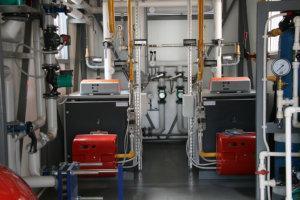In manufacturing and industrial facilities, furnaces are a mainstay making furnace temperature measurement tools such as furnace temperature probes, and furnace temperature sensors vital. Ultra high temperature furnaces are utilized to generate substantial amounts of heat in a controlled manner through the combustion of a fuel source. Also known as a direct-fired heater or direct heater, an industrial furnace temperature range burns higher than 400 degrees Celsius to provide process heat or act as a reactor that heats a reaction. Some of the most common applications for industrial furnaces include:
- Metallurgical production for smelting
- Heat treatment
- Tempering
- Food industry for drying
- Low-temperature fermentation
Regardless of the application, industrial furnaces are usually required to superheat materials to extremely high temperatures using different formats and fuels. Because of these high operating temperatures, it’s imperative that a temperature sensor for a furnace provides accurate furnace temperature measurement information, especially:
- The amount of heat to be transferred to the material
- The amount of heat necessary to heat the mass and the loss.
Let’s take a closer look at take a closer look at the benefits of furnace calibration, how the industry benefits from boiler temperature sensors in industrial furnace operation.

A Closer Look at Industrial Furnaces in the Metal Industry
The metal industry represents a substantial share of total energy consumption. When used in the metal industry, furnaces must operate in very high-temperature zones:
- Cooking of enamel — 600°C to 1100°C
- Heat treatment of metals —1100°C
- Extrusion, rolling, cooking of ceramic materials, pressing and heat treatment — 1350°C
- Smelting and melting of metals — 1700°C
Industrial furnaces can be used for a wide range of activities within the industrial and manufacturing environment. But no matter the application, both contact and infrared thermometer temperature sensors are relied upon to provide accurate information.
What Temperature Sensors Are Used on Furnaces?
When it comes to the best-infrared thermometer or temperature sensor used on furnaces, there are no one-size-fits-all solutions. The type of metal temperature sensor used in boilers can vary by budget as well as application. The three most common types of industrial furnace temperature probes are:
- Thermocouples
- Resistance Temperature Devices (RTDs)
- Thermistors
Thermocouple Temperature Sensors on Furnaces and Boilers
Thermocouples are extremely accurate and versatile temperature sensing devices used for measuring temperatures inside furnaces and boilers. Thermocouples essentially determine temperature based on the variance in voltage created by dissimilar metals joined together at an end. These devices are primarily used for metal temperature measurement in boilers and for furnaces because they can measure the widest span of temperatures.
Type K Thermocouple Sensors
Most often, nickel alumel and nickel-chromium are the types of metals used to create the Type K thermocouple. This type of thermocouple is a very popular furnace temperature probe because it’s inexpensive and can be used across a vast range of temperatures, such as -200 to 1250°C (-328 to 2282°F). To cater to different industrial needs, Type K thermocouples are also available for narrower temperature ranges, such as 200 to 1250°C, ensuring precision in environments that do not require the full spectrum of temperature measurement.
Resistance Temperature Devices & Sensors on Furnaces
RTDs use metal conductors that have a well-known temperature-to-resistivity relationship to detect a measurable temperature signal influenced by the temperature of the conductor. The temperature-to-resistivity relationship of certain metallic materials is consistently repeatable and relatively linear, which makes RTDs very desirable in applications that require high levels of accuracy. Similar to thermocouples, RTDs can detect a wide range of temperatures. RTDs can even be used to detect ultra-low temperatures down to 10 milliKelvins.

What Metals Are Used in RTDs?
The most common and regularly-used metal in RTDs is platinum. As you can figure, platinum is very expensive, which makes RTDs less cost-effective than other temperature sensors used in furnaces. More cost-efficient RTDs use film or copper materials. Yet, these RTD temperature sensors are less repeatable and less linear than platinum RTDs.
Thermistor Temperature Sensors Used on Furnaces
While thermistor sensors are a cheaper alternative, they do not have the accuracy, linearity, or temperature range of RTDs. And this difference can mainly be attributed to the materials used to build the furnace temperature probe. Thermistor temperature sensors used on furnaces are often made from polymer blend or ceramic. Thermistors are particularly effective in environments that reach 1250°C (328°F), where precise temperature monitoring is critical for process control.
Thermistor Furnace Temperature Probes Perform Best in High-Temperature Fluctuating Environments
The thermistor furnace temperature probe is mainly negative temperature coefficient (NTC). This means their resistivity decreases when temperatures increase. NTC thermistor temperature sensors on furnaces have an exponential output relationship. This requires linearization circuitry, but thermistors have minimal latency. Because of this, these types of probes are more desirable in environments with temperatures that fluctuate.
How Can Furnace Temperature Sensors Save Money?
Choosing the right temperature sensor for your furnace application can lead to significant savings and efficiencies. Your furnace’s ability to accurately measure and sense temperature levels can help reduce system run time. Simply put, when your furnace system has better data, it will be best positioned to make better decisions. In addition, the right temperature sensor can help:
- Detect potential hot spots, faults, leaks and temperature imbalances.
- Maintain the necessary quality guidelines
- Reduce fuel costs
- Reduce electrical power cost
- Bolster the quality of the final product
- Help ensure customer satisfaction
Key Takeaways
- Furnace temperature probes are key to the successful operation of boilers and furnaces.
- The temperature sensor is tasked with accurate metal temperature measurements in boilers and furnaces.
- The three primary types of temperature sensors used on boilers and furnaces are RTDs, thermocouples and thermistor sensors.
- Choosing the right temperature sensor can lead to cost savings, improved final product, and improved customer satisfaction. Accurate measuring temperatures within the furnace are crucial for process efficiency and energy conservation.
Contact Temp Pro
When it comes to choosing and finding the best furnace temperature sensor, the team at Temp-Pro can help. We offer an array of furnace temperature measurement products and solutions designed to improve the performance and efficiency of your furnace or boiler.
Contact Temp Pro today for more information!



